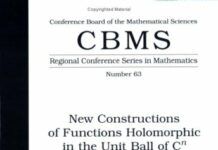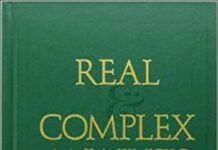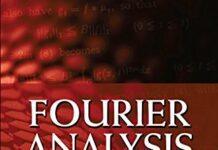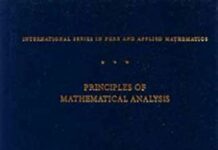
Ebook Info
- Published: 1976
- Number of pages: 342 pages
- Format: PDF
- File Size: 12.22 MB
- Authors: Walter Rudin
Description
The third edition of this well known text continues to provide a solid foundation in mathematical analysis for undergraduate and first-year graduate students. The text begins with a discussion of the real number system as a complete ordered field. (Dedekind’s construction is now treated in an appendix to Chapter I.) The topological background needed for the development of convergence, continuity, differentiation and integration is provided in Chapter 2. There is a new section on the gamma function, and many new and interesting exercises are included. This text is part of the Walter Rudin Student Series in Advanced Mathematics.
User’s Reviews
Reviews from Amazon users which were colected at the time this book was published on the website:
⭐For the Brave and the Determined, learning analysis from Principles of Mathematical Analysis (PMA) is a sublimely rewarding experience. (Dilettantes keep away.)PMA, a.k.a. ‘Baby Rudin’, is an introductory text in analysis for the serious student of mathematics. Back in 2004, this was the text used for the first semester of Harvard’s freshman analysis/linear algebra course (Math 25, modestly titled “Honors Multivariable Calculus and Linear Algebra”, the lite version of the infamous Math 55 sequence). A majority of students in the course came in with a working knowledge of proof writing, through high school mathematical olympiads, upper division college classes elsewhere, or both. Although the professor (Tom Coates, now of Imperial College London) was an excellent lecturer and was very helpful and patient, students without a background like this (“mathematical maturity”) were generally left in the dust. Those of us who persisted in the course after the first few weeks found ourselves spending 15 to 20 hours a week working problems assigned from PMA or written by Prof. Coates. Problems in PMA ranged simple verifications, taking maybe five minutes of thought, to problems barely within the grasp of the smartest students in the class, taking many hours of struggle spread out over a few days.Content: As many reviewers have already noted, PMA is simply the best out there in terms of clear, concise mathematical exposition of one-variable advanced calculus (Chapters 1-8). Though known by analysts for his contributions to harmonic and complex analysis, Dr. Rudin ensured himself a permanent place in the canon with the publication of this text and its graduate-level companions “Real and Complex Analysis” and “Functional Analysis”. Having browsed through copies of the first (1953) and second edition (1964), it’s clear that the author “perfected” an already very well written text in this third edition (1976) and said “that’s it” to greedy textbook publishers wishing to make money off of newer editions. Other than correcting some typos, this text has remained the same for four decades (and will remain so with Dr. Rudin’s passing in 2010). Its continued use, more than six decades after it was first published, is a testament to the quality of this textbook. Here’s a brief overview of topics covered. Chapter 1 introduces the real number system, the most important concept being the least upper bound property of the real numbers. An appendix constructs R from Q using the Dedekind approach. While the entire book is succinct and fantastically organized, chapter 2 on metric space topology deserves particular mention. This concisely written chapter (only 23 pages!) is strategically placed to serve as a cornerstone for the rest of the book. Assuming only rudimentary knowledge of sets and functions, Rudin gives the reader just a taste of topology to enable subsequent discussions on continuity and convergence to proceed in a general and abstract setting. Several interesting but less pertinent ideas (like the Baire category theorem) are included as challenging exercises at the end of the chapter. Though the abstraction introduced is challenging and most beginners won’t see the point (yet), the reward is substantial, enabling celebrated theorems (e.g., Arzelà-Ascoli, Stone-Weierstrass) to be proved cleanly and quickly later on. The usual topics (limits, continuity, differentiation, and Riemann(-Stieltjes) integration) are covered in chapters 3-6. This is followed by an in depth discussion on sequences of functions, focusing on the interchange of limiting operations and polynomial approximation, in chapter 7, topics often discussed in a cursory manner in other introductory analysis textbooks. The coverage of power series at the beginning of chapter 8 seems to come a bit too late, given the importance of this concept; Rudin uses it as a springboard for rigorously defining the functions that everyone thinks they know (exp, log, sin, cos), followed by an outline of the Beta and Gamma functions and their miscellaneous properties, and an introduction to Fourier series. The topics at the end of chapter 8, while interesting, are not essential for a first course in real analysis. Back then, in Math 25a, we covered chapters 1-7 and the first half of chapter 8, minus the appendix on Dedekind cuts at the end of chapter 1 in 14 weeks. That still left us with one week of class, during which we started to cover linear algebra to get a head start on Math 25b in which real analysis of several variables was the main topic. (My freshman year roommates could not comprehend why anyone would be such a masochist….)In the remaining chapters, Rudin covers analysis on several variables (chapters 9 and 10), including differential forms and the generalized Stokes Theorem, and measure and Lebesgue integration (chapter 11). These chapters have been the subject of criticism, mostly due to their bare bones coverage of these intricate topics. In my opinion, they really are too lean to be pedagogically useful introductions. Moreover, chapters 9 and 10 would have benefited from figures or line drawings, given the geometric nature of the topic, but PMA seems to avoid these at all costs. (Rudin’s definition of differential forms is essentially algebraic and makes no appeal to geometric intuition.) Nevertheless, because they are written in such a concise manner, they are useful as “cliff notes” or refreshers on these topics for review after learning them elsewhere. Besides the terseness, Rudin’s outlines of these topics do not provide the reader with their full mathematical machinery, leaving out many important subtleties and non-elementary constructions (e.g., PMA develops forms in a way that only implicitly references their tensorial nature, defining them as formal expressions that are only meaningful behind an integral sign, rather than a mathematical construction in their own right, while measure theory is developed somewhat unconventionally using sigma-rings rather than sigma-algebras, which actually complicates some of the subsequent propositions), so one is well-advised to find other resources to become acquainted with these topics. For multivariable calculus, Spivak’s “Calculus on Manifolds” is concise though hard-to-digest without a good instructor, and it should be supplemented by Halmos’s “Finite-Dimensional Vector Spaces” or Axler’s “Linear Algebra Done Right” to provide the requisite abstract linear and multilinear algebra background. Munkres’s “Analysis on Manifolds” is a better alternative for self study (see my Review on this book). Bartle’s “Elements of Integration and Lebesgue Measure” provides a clear though not particularly thorough introduction to Lebesgue theory. Stein and Shakarchi “Real Analysis” also has an excellent introduction to measure theory and Lebesgue integration, and covers many other fascinating topics, but it is annoyingly not self-contained and references the earlier two volumes. (Math 25b ended up using Halmos and Spivak; Lebesgue integration wasn’t covered, so it became summer reading.)Style: With the exception of a short introductory paragraph at the beginning of each chapter, the book consists almost entirely of a series of statements labeled Definition, Theorem, or Corollary (in that order) with only an occasional Example or Remark squeezed in. (The Examples and Remarks are important — they generally address subtleties or common points of confusion for students.) This format is probably shocking and baffling for most people who start reading PMA. Persevere — it will grow on you! Through his austere presentation, Rudin lets the beauty of the mathematics speak for itself. Flipping through my tattered and scribbled-on copy of the book from 2004-2005, I still marvel at the elegance and polish of the proofs — without a wasted symbol or syllable yet completely rigorous if you put in the effort to scrutinize his arguments. Precisely for these reasons, however, students will find themselves reading and re-reading the text to try to figure out how Rudin managed to construct a proof and/or where the idea behind it came from. The diligent student should have pencil and paper in hand to try to construct his/her own arguments, which should lead to insights into Rudin’s (more elegant) proofs. Also, since Rudin rarely remarks upon why the hypotheses of a theorem cannot be weakened, it is extremely useful to have concrete examples or counterexamples in mind when working through a proof. In retrospect, I found that it was this type of between-the-lines reading of the text, together with the excruciating process of working through the exercises, that led to true comprehension: no pain no gain!Ideally, a professor teaching from this text should motivate the definitions (and even some of the theorems) presented in PMA during class. (It’s not always clear why Rudin proves something; he doesn’t distinguish between main theorems and lemmas.) However, if you are teaching yourself, a less formal exposition with more examples and explanations and occasional diagrams to illustrate difficult concepts or facilitate intuition will probably be useful to read with PMA concurrently. Pugh’s “Real Mathematical Analysis,” comes to mind. (Though at times wordy or long-winded, it adopts a conversational and infectiously enthusiastic tone. In addition, Pugh’s text contains a large collection of interesting and sometimes extremely challenging problems. Highly recommended as a foil to PMA!) I understand why some say that PMA should not be used as a first text. However, I feel that the point of learning analysis is to be able to appreciate a beautiful branch of mathematics (as opposed to do something useful, like with calculus or diffeqs). Rudin offers exactly this, given the proper preparation. It’s well worth the time and effort to work through PMA and see analysis the way it was meant to be seen, rather than to be introduced to a dull, watered-down version.A final remark about the style: if PMA sometimes reads like a collection of lecture notes, it’s probably because it started out that way. When Rudin, then a freshly minted Ph.D., started teaching real analysis as a lecturer at MIT in 1950, there were very few analysis textbooks in English. Available texts like Hardy or Titchmarsh presented the classical approach without reference to topological notions. Because of the lack of suitable modern treatments of real analysis, he ended up writing one for his course. The first edition of PMA was published only three years later in 1953, based on the class that he taught. As the first text of its kind in English, PMA provided a model for the treatment of modern ideas in almost all subsequent English language textbooks in introductory analysis.Don’t get discouraged! This is probably not like any textbook you’ve previously encountered (but this is the way mathematicians tend to write — they don’t like extra words and they certainly don’t try to spoonfeed…). Spending hours to fully comprehend a few pages might feel crushing, but unless you’re clearly destined to become a math professor, it will likely happen at some point when you study Rudin (e.g. his proof on the uncountability of nonempty perfect sets in chapter 2 for me). Bravely trudge ahead when it happens; it builds character, and it will eventually lead to a deeper, more intuitive and more satisfying understanding of analysis.
⭐Payed $115 in 2015 from here for brand new. The content is unchanged, and quality has decreased it seems according to other reviews. It seems you have quite the choice to make.I like the book, and I don’t like the book. I am a senior math major bound for math grad school, if authority matters.Weighing in on the multivariable portion,I have already taken differential geometry, learned forms, etc. From my perspective after learning that elsewhere, looking at the forms part in this book is not terrible, nor really bad, but it’s not a place to learn them. It’s not really possible, they’re much more than this book indicates. Look at Bachman’s book for them.The later chapters are pretty much stuff you’d learn in advanced calculus, and then most of the time you don’t take real analysis freshman year anyway, maybe possibly at some ivy league crazy school where everyone fails. Ideally you’ll know what you need to know before you try this book, and therefore it’s all fine. I don’t think this is the place to really learn any new concepts, per se. It’s more about putting those on a firm foundation, analysis.This book is more of a toy to me, a neat thing, like Calculus on Manifolds by Spivak(also a waste of time, go elsewhere.) They’re cool look at when you don’t know the material, they’re way to ridiculous to learn from, then when you know it, they’re just a neat thing.
⭐There are two kinds of books worth reading: those which give a very quick introduction to an area of math, and those which take a basic understanding of the material and rebuild it. This book falls into the second category, which gives it it’s status as a second book in analysis. I feel that it is essential reading for any aspiring mathematicians for several reasons.The first is that there is a huge difference between advanced calculus and introductory real analysis. While they both tend to deal with the same material, it is the style, methods, and level of thought that differentiate them. In a typical advanced calulus book like Spivak, the reader learns how to manipulate epsilons and deltas, and everything about everything is proved using epsilon-delta techniques. Rudin, on the other had, often works in more generality. Instead of resorting to epsilons and deltas, Rudin will often use techniques like reformulating continuity in terms of sequences as a way to bypass many technicalities and provide much more elegant and intuitive proofs. This is not to say that Rudin doesn’t provide the standard definition, but the fact is that Rudin knows how to use which methods of continuity/limits/ etc in the most effective way, and all of them get their fair share. This leads to what many people have deemed as “slick proofs.” In reality, the proofs are very complete, but just a bit more advanced then what is typically seen in an introductory real analysis book. It is really important that students get used to working with other definitions of continuity simply because they will, sometime in the future, find themselves working in an abstract space where producing a metric is either impossible or finicky. Either way, having prior exposure to other techniques would greatly set those students apart.Going back to the higher level of thinking theme, chapter 2 of this book deals with the bare minimum of topology. This chapter serves for providing the proper abstract setting in which many topics like sequences and continuity will be studied. Studying these topics in greater generality trains the reader to not only think analytically, but topologically as well. This topological viewpoint leads to deeper insight than what a traditional real line only approach will allow for. For a quick example, consider the intermediate value theorem. Ask a student who recently studied out of Spivak or Apostol to prove this, and you’ll get a sea of epsilons and deltas. They probably won’t be able to provide it, because in all honesty the proof is not incredibly intuitive. Compare this to the proof given in Rudin using topological tools. Rudin basically says “the image of a connected set under a continuous function is connected.” And this is the proof. Not only is the proof much more slick, but those who have learned to apply topological intuition to analysis will gain more insight into how continuous functions behave. This is the type of advanced viewpoint that I feel is a theme throughout all of Rudin’s books, and is one the most students will need to learn at some point.I should stress that this book probably shouldn’t be used as one’s first exposure to formal mathematics, and probably not even to analysis. One risks the ability to swiftly manipulate with epsilons and deltas, and more importantly a reader might not gain the strong intuition for how functions behave on the real numbers if this is his or her only book. However, when paired up with a book like Spivak’s
⭐, the diligent reader will come away with an unshakeable understanding of basic real analysis.
⭐one of the best books I’ve read
⭐Walter Rudins Buch „Principles of Mathematical Analysis“ polarisiert seit Genartion seine Leser, die einen nennen es reine ‘Bourbakisten Propaganda’, andere möchten es kanonisieren; auf jeden Fall ist es eine der prägnantesten Einführung in die (reelle) Analysis in moderner Darstellung und wird oft als „Baby Rudin“ bezeichnet – in Abgrenzung zum „Big Rudin“ (Real and Complex Analysis).Der Autor folgt in der Tat dem Prinzip der ‘Denkökonomie’ und führt die elementaren Konzepte der Analysis, wie Konvergenz und Stetigkeit, von vornherein abstrakt in Termen von metrischen Räumen ein. Die Darstellung ist präzise und streng, die Beweise sind ausgefeilt und ein Muster von Minimalismus, exakt, wenn auch Zwischenschritte gern dem Leser überlassen werden – insofern sind die ‘Princples’ auch ein wunderbares ‘Arbeitsbuch’ zur Analysis, der aufmerksame (und geduldige) Leser, wird die Auslassungen leicht füllen können.Das Buch beginnt zunächst ganz traditionell, mit einer Einführung der reellen Zahlen als geordneter Körper mit kleinster oberen Schranke Eigenschaft, im Anhang zum 1. Kapitel wird die Existenz eines solchen Körpers mittels Dedekindscher Schnitte bewiesen. Es folgt ein knapper Abriss der Topologie, es werden metrischen Räumen eingeführt, und die Begriffen offener und abgeschlossener Mengen bereitgestellt, ferner werden die anspruchsvolleren Konzepte der Kompaktheit und des Zusammenhangs erläutert.Die weiteren Themen sind: Konvergenz und Stetigkeit in metrischen Räumen und spezialisiert auf numerische Folgen bzw. Funktionen, Differentiation von Funktionen einer Variablen, Riemann Stieltjes Integrale, Funktionen Folgen und Reihen, sowie spezielle Funktionen – gemeint sind Exponential- , Logarithmus und trigonometrische Funktionen, Fourier Reihen und die Gammafunktion.Der nächste Teil entwickelt die Theorie von Funktionen mehrerer Variablen: es werden Differentiale als lineare Approximationen und partielle Ableitungen betrachtet, das Inverse Funktionen Theorem wird mittels eines Fixpunkt Prinzips für kontraktive Abbildungen bewiesen, daraus werden das Implizite Funktionen und das Rank Theorem abgeleitet.Die Entwicklung der Vektoranalysis auf der Grundlage von Differentialformen ist einem Analysis Einführungskurs nicht unbedingt üblich, Rudin wählt trotzdem diesen Weg – eines seiner ‘Extras’ –, das erlaubt es ihm, die Vektoranalysis auf ein wichtiges Theorem zurückzuführen; der Weg dahin wird nur minimalistisch ausgeführt: multidimensionale Integrale werden als iterierte Integrale einführt und einige elementar Eingenschaften bereitgestellt, danach werden k-Formen als Objekte auf n-dimensionalen Mengen, die sich auf k-dimensionalen ‘Teilen’ davon integrieren lassen ‘identifiziert’; der Randoperator wird auf Ketten von k- Symplices betrachtet, damit sind sind Zutaten bereitgestellt , um den Satz von Stokes für k-Formen zu formulieren und zu beweisen. Daraus lassen sich – mittels einfacher Umformungen – alle üblichen Integralsätze der Vektoranalysis ableiten.Note: die Abschnitte über Funktionen mehrerer Variabler und Differentialformen wurden in der vorliegenden 3. Auflage (1976) wesentlich überarbeite.Das letzte Kapitel ist dem wahrscheinlich ungeliebtesten Kind eines Analysis Kurses – der Lebesgueschen Integraltheorie – gewidmet; ungeliebt wohl deswegen, da das Thema, gleich welche Weg mal wählt, langwierige Entwicklungen von Hilfskonstruktionen erfordert (Mengen Ringe und Algebren, mit entsprechenden Inhalten/ Maßen, deren Fortsetzungen, der Konstruktion geeigneter Funktionen, aus denen dann die integrierbaren herauszuschälen sind) , um am Ende eine recht magere Ausbeute an wichtigen Sätzen und Resultat zu erhalten – im Vergleich, was mit Riemannschen Integralen bereits möglich war. Dem ungeachtet, stellt sich der Autor der Herausforderung, allerdings wird das Material in diesem Kapitel – selbst für Rudins Maßstäbe – nur skizziert, etliche Eigenschaften werden als offensichtlich ‘abgetan’, d.h. Beweise sind Sache des Lesers. Auch hier gelingt es dem Autor, dass nach einem Parforceritt dem Leser schließlich die grundlegenden Eigenschaften von L^1 und L^2 Räumen zur Verfügung stehen.Jedes Kapitel enthält zahlreiche Aufgaben, die zum Teil den stromlinienförmig formulierten Text um weiteres Material ergänzen und vertiefen.Fazit: der „Baby Rudin“ ist ein exzellentes Lehrbuch zur Einführung in die (reele) Analysis, das in wohlüberlegt gedrängter Form etwa das Material eines einjährigen Kurses abdeckt, darüber hinaus noch etliche Extras enthält, die eine elementare Einleitung nach modernen Prinzipien abrunden. Es war und ist Grundlage oder Inspiration für zahllose Analysis Vorlesungen, und ist außerdem ausgezeichnet zum Selbststudium geeignet.
⭐Not found.
⭐Una edición de pésima calidad: mal empastado, mala calidad del papel, mala calidad de impresión. No está cosido, por lo que se deshoja de abrirlo la primera vez. Por el precio asociado esto es un robo. Mejor buscar una versión usada de ediciones anteriores.
⭐Not found.
⭐This review concerns the McGraw-Hill International Edition ONLY: the book itself is great and deserves 5 stars.The edition I bought is rather expensive (around 65 euros) but its quality is very poor. The paper is very cheap and the book hardy stays open. The worst thing is that this edition is a scan of some other edition, and a very bad one: some characters are missing, some pages are dark and some others are so pale that it is hard to read them. Clearly, nobody from the publishing house has ever read this book before publication. Overall the book is readable, but in my opinion its quality is not adequate for publication, especially considering its price.
⭐Not found.
⭐The physical quality of this book, for the price, is robbery. It’s like 1-ply toilet paper glued to cardboard.
Keywords
Free Download Principles of Mathematical Analysis (International Series in Pure and Applied Mathematics) 3rd Edition in PDF format
Principles of Mathematical Analysis (International Series in Pure and Applied Mathematics) 3rd Edition PDF Free Download
Download Principles of Mathematical Analysis (International Series in Pure and Applied Mathematics) 3rd Edition 1976 PDF Free
Principles of Mathematical Analysis (International Series in Pure and Applied Mathematics) 3rd Edition 1976 PDF Free Download
Download Principles of Mathematical Analysis (International Series in Pure and Applied Mathematics) 3rd Edition PDF
Free Download Ebook Principles of Mathematical Analysis (International Series in Pure and Applied Mathematics) 3rd Edition




